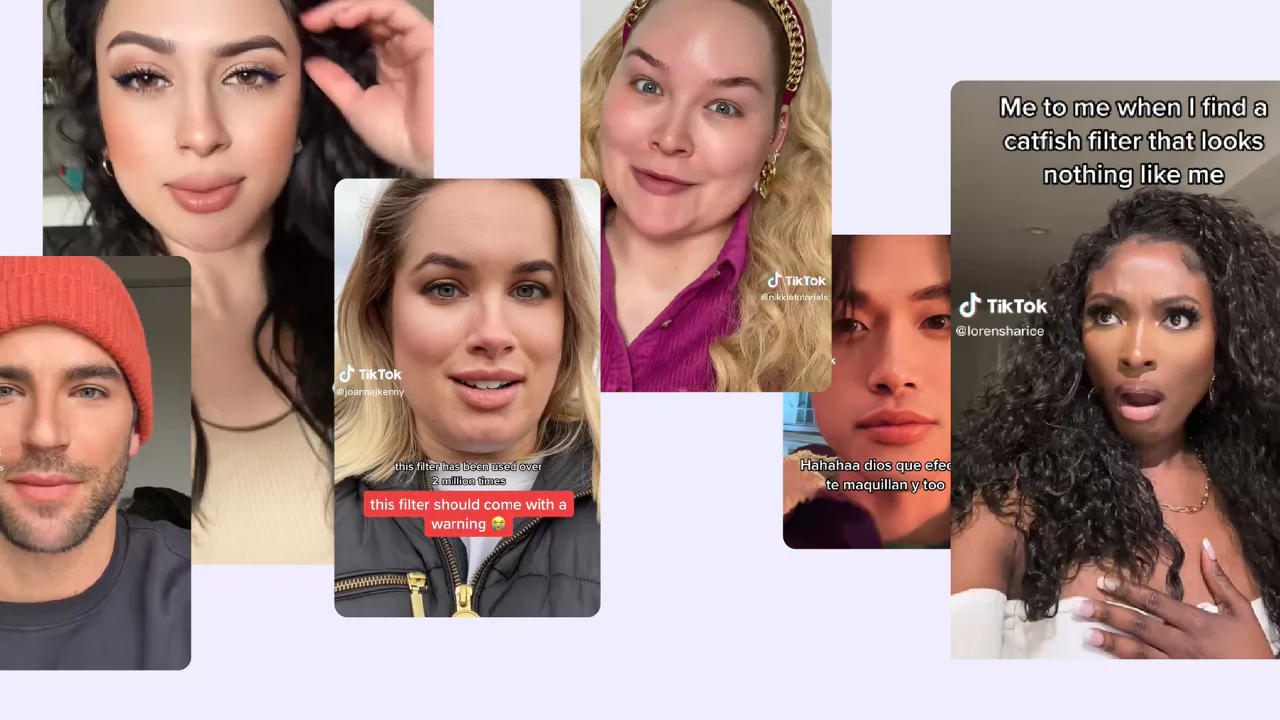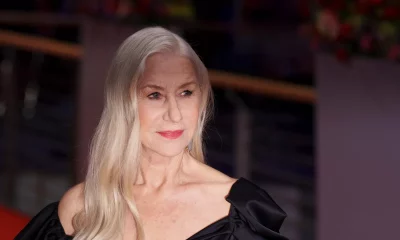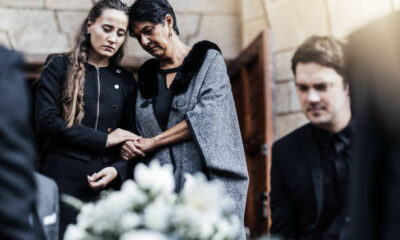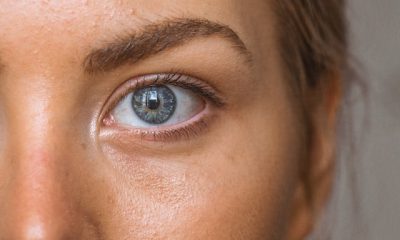News
Hyper-realistic beauty filters are the new hype on TikTok: “Insecure young people can become even more unhappy about this”

The new lifelike filter “Bold Glamour” on TikTok uses artificial intelligence to give you a “perfect” look. The beauty filter is extremely popular, and therefore not without dangers. “Young people start to compare with their unfiltered appearance, and this can make them unhappy,” says social media expert Laura Vandenbosch (KU Leuven).
Full lips, defined eyebrows, enchanting eyes, long eyelashes, whiter teeth, tight cheekbones and smoothed skin. For example, the new TikTok filter “Bold Glamour” seamlessly transforms your entire face. The filter has been used almost 16 million times. Just days earlier, TikTok was flooded by a similar filter that transforms you into a teenager.
Where with other beauty effects you often clearly notice that there is a filter over your face, the new filters are hyper realistic. The difference between reality and the filter is almost invisible. That’s because the filter uses a form of artificial intelligence that processes data and learns from it to perform better, called “machine learning”.
The filter detects certain features of your face, compares them to a dataset full of other photos of faces and adjusts those features based on prescribed beauty ideals.
WATCH – Luke Hurd has created effects for Snapchat and Instagram and explains the mechanism behind “Bold Glamour”:
Plastic surgery
The filters have been criticized for their impact on some users’ self-esteem. Your face completely merges with the artificial features, which also makes it incredibly realistic for yourself. “Some young people then start comparing themselves to their unfiltered appearance, and that can have a negative effect on their self-image,” says Professor of Media Effects Laura Vandenbosch (KU Leuven). “We see that young people may even gravitate towards plastic surgery to pursue the filtered face.”
During her PhD, researcher Chelly Maes (Leuven School of Mass Communication Research) conducted research together with Vandenbosch into the use of filters by 12 to 18-year-olds. She found a clear link between the use of beauty filters and the intention to undergo plastic surgery later on. Of the 444 respondents, 46.2 percent indicated that they were positive about using plastic surgery for their own motivations, such as to feel better. In fact, 20.5 percent intend to use plastic surgery later.
11 to 12 year olds
“Not everyone is susceptible to the effects of beauty filters. But they make young people who already have low self-esteem even more unhappy,” explains Vandenbosch. “The more young people are motivated to look more beautiful, through all kinds of beauty filters or processed images, the more young people will compare their appearance to it. The filters normalize a very narrow ideal about what beauty is, while it is important that young people see different faces see,” says Vandenbosch.
If such filters make some young people unhappy and even persuade them to change their face, Vandenbosch wonders why social media bets on it. “Social media is aware of the effects of beauty filters. Should they be made accessible so that every TikTok user can test them in a few clicks?”
Especially the youngest users should be protected. “Many 11 to 12-year-olds start using TikTok to have fun, and are not focused on appearance,” Vandenbosch emphasizes. “Through those filters they are confronted with beauty and unrealistic ideals.”

News
News Ukraine War

Ukraine War: Escalation, Impact, and International Response
For almost a decade, the world has been concerned about the violence in Ukraine. Situation has worsened since it began in 2014 with Russia’s invasion of Crimea and the ensuing pro-Russian separatist movements in Eastern Ukraine. When I last updated my information in September of 2021, things were already quite serious. The purpose of this article is to provide readers an overview of the conflict in Ukraine by discussing its background, the humanitarian impact, and the international response thus far.
A Background on the Ukraine War
Russia’s annexation of Crimea in 2014 sparked a surge of upheaval and instability in Eastern Ukraine, which eventually escalated into full-scale conflict. Ukrainian army and pro-Russian rebels fought bloodily after the former proclaimed independence from the latter. The Ukrainian government, supported by Western countries, accused Russia of equipping and backing the rebels. Russia has repeatedly rejected the allegations, despite mounting evidence to the contrary.
The OSCE organized a series of agreements to end the fighting and bring about peace in the region, most notably the Minsk Accords. The goals of these accords were to reduce hostilities, facilitate prisoner swaps, and create a stable truce. However, ceasefires were often broken, and the fighting continued, with each side blaming the other.
Humanitarian Toll
The horrific human cost of the Ukraine conflict cannot be overstated. Countless lives have been lost and communities have been ripped apart as a result of the violence, which has touched millions of people. Hundreds of thousands of Ukrainians have been forced to flee their homes and seek asylum either inside Ukraine or in neighboring countries as a result of the fighting.
The civilian population has taken the greatest hit, suffering from shelling, bombing, and a dearth of needs as a result of the war. Attacks on hospitals and schools, as well as other key infrastructure, have worsened the situation for the local populace. Security concerns have made it difficult for humanitarian organizations to reach those in need and deliver relief in places impacted by war.
International Responses
The crisis in Ukraine has been the focus of diplomatic and peacemaking efforts on a global scale. Several major parties have been actively engaged in mediation efforts to end the fighting:
United Nations:
In terms of diplomatic efforts and humanitarian aid, the United Nations has been a helpful partner. There has been no all-encompassing solution to the Ukraine conflict brought about by the Security Council’s resolutions on the issue there.
European Union:
In reaction to Russia’s aggression in Ukraine, the European Union (EU) slapped economic sanctions on the country. It has also provided financial help and diplomatic support to Ukraine. The European Union has repeatedly demanded that the dispute end peacefully.
United States:
The United States has been a strong advocate for Ukrainian interests, including through the provision of military aid and the imposition of sanctions on Russia. The crisis has strained relations between the United States and Russia.
Russia:
Russia has always said it had nothing to do with the crisis and calls it a civil war. Moscow has played a pivotal role in talks and accords to end hostilities.
OSCE:
The OSCE’s role in keeping an eye on things and helping to broker peace negotiations has been crucial. The OSCE-mediated Minsk accords have served as a crucial basis for talks.
Unfortunately, a stable peace in Ukraine has eluded international efforts thus far. There have been intermittent flare-ups of violence, and the war has continued to simmer.
Escalation and Stalemate:
A shaky truce that was regularly breached characterised the situation in Ukraine as of my most recent information update in September 2021. Clashes between Ukrainian soldiers and rebels in Eastern Ukraine often escalated. There was still a lot of tension between Russia and Ukraine over the status of Crimea, and talks on Donetsk and Luhansk hadn’t gotten very far.
Eastern Ukraine’s economy had suffered the most as a result of the fighting. The Ukrainian government faced formidable difficulties in repairing infrastructure and recovering from the war’s economic effects.
Conclusion
A prolonged and destructive conflict, the war in Ukraine has had far-reaching effects on the Ukrainian people and regional stability. Despite international attempts to end the fighting, the humanitarian situation in Eastern Ukraine remains precarious, and the region is no safer.
The problem is nuanced, with political, historical, and ethnic considerations all playing a role in why this dispute refuses to be resolved. Diplomatic attempts from major players including Ukraine, Russia, and Western nations continue, but a sustainable and comprehensive peace has yet to materialise.
It is crucial for the international community to keep focusing on the conflict in Ukraine, keep funding humanitarian assistance, and keep taking diplomatic steps towards ending the fighting. Conflict resolution will need long-term dedication from all sides and a willingness to deal with the underlying causes of the problem. Only then will the Ukrainian people be able to look forward to a future unaffected by conflict.
News
Teltlk: Cutting-Edge Communication Technology That Will Change the World

In today’s fast-paced, globally interconnected society, the value of clear and effective communication cannot be stressed. Modern technological advancements have tremendously simplified interpersonal communication. Teltlk is one such cutting-edge technological advance. Modern communication platforms like Teltlk have revolutionised how we interact with one another and spread knowledge. In this paper, we’ll look at how Teltlk has changed the face of modern communication in a variety of contexts.
Teltlk: what is it?
Teltlk is a modern messaging service that streamlines all of your preferred means of communication into a single, user-friendly interface, making it simpler than ever to get in touch with colleagues and collaborate effectively. It provides an unprecedented degree of interconnection through the utilisation of state-of-the-art technologies like AI, cloud storage, and real-time data processing. Teltlk is a versatile communication system since it can be customised to match the needs of any organisation or individual.
Teltlk’s Main Attributes
- Voice and video calls, instant messaging, and teleconferences may all be conducted from within Teltlk, making it a unified communications platform. This unified interface increases productivity because switching between applications is unnecessary.
- Tel’tlk employs only the highest quality audio and video codecs, guaranteeing crystal-clear calls and seamless video streaming. Whether it’s a one-on-one conversation or a group video call, the HD audio and video quality offered by Teltlk makes for a truly immersive experience.
- Several real-time collaboration technologies, such as file and screen sharing and digital whiteboards, are made feasible via Teltlk. Allowing users to quickly share their displays and papers during meetings improves communication and productivity.
- Teltlk’s virtual assistant is intelligent and can assist you with nearly any task you may have. Time can be saved and procedures simplified by using tools that allow one to arrange meetings, send out reminders, and provide conversational context.
- Teltlk uses advanced encryption methods to protect user data and ensure users’ privacy. Using end-to-end encryption and safe user authentication methods, Teltlk keeps private and sensitive data safe.
Teltlk’s Advantages
Tel’tlk boosts production and efficiency by easing communication and fostering harmonious collaboration among team members. By eliminating the need for several channels of communication, this method is more efficient.
Teltlk users have greater mobility because they can hold conversations whenever and wherever they have an internet connection. Whether working remotely or in the office, users may effortlessly maintain contact and conduct fruitful discussions.
By consolidating a company’s disparate communication infrastructures into a single, easy-to-use platform, Teltlk helps save money by reducing administrative burden. Teltlk is also a low-cost alternative because it requires no complex hardware configurations.
Teltlk’s scalability frees businesses from being constrained in their growth by the limits of their communication infrastructure. Tel’tlk is designed to expand as your company’s user base and communication requirements do.
Better Interactions with Customers:
T Eltlk enables an unprecedented degree of simplification in the ways in which businesses interact with their customers. Tools like chatbots and intelligent routing allow for rapid response to customer inquiries.
Teltlk is a unified communication interface that combines many methods of contact into a single interface, including voice calls, video calls, IM, and teleconferencing. As switching between apps or devices is no longer necessary, productivity is increased thanks to this one interface. Users of Teltlk can easily switch between chatting, calling, and video conferencing without missing a beat.
Teltlk uses cutting-edge audio and video codecs to provide the highest quality voice and video calls possible. Whether you’re having a one-on-one chat or a group video call, you’ll be immersed in the conversation thanks to Tel’tlk’s HD video and audio. This high standard of communication ensures that all parties involved are able to have productive and meaningful exchanges with one another.
Screen sharing, file sharing, and virtual whiteboards are just a few of the real-time collaboration tools made possible by Teltlk. Meetings can be more productive and collaborative when participants can easily share their screens and materials. Teltlk allows distributed teams to present and discuss slides, generate and refine ideas on a shared digital whiteboard, and modify documents in real time.
Teltlk has a built-in AI-powered virtual assistant called the Intelligent Virtual Assistant. Meetings may be scheduled, reminders can be issued, and conversational context can be provided, all while saving time and streamlining processes. The virtual assistant in Tel’tlk improves productivity and helps users streamline their communication processes by making use of natural language processing and machine learning technologies.
Conclusion
Teltlk is a game-changer in the realm of communication technology since it offers a single, comprehensive solution to all of today’s pressing communication problems. Because of its many useful functions, high-quality audio and video, and commitment to privacy and anonymity, Teltl’k has become a vital tool for both individuals and businesses. Tel’tlk is cutting-edge technology in the realm of contemporary communication since it facilitates user cooperation and success in a digital world. Increased efficiency, greater agility, lower costs, and improved client experiences are just a few of the numerous ways in which Tel’tlk has revolutionised our digital interactions and communications.
News
The New Bing and Edge – Progress from Our First Month

It’s hard to believe it’s been just over a month since we released the new AI-powered Bing and Edge to the world as your copilot for the web. In that time, we have heard your feedback, learned a lot, and shipped a number of improvements. We are delighted by the virtuous cycle of feedback and iteration that is driving strong Bing improvements and usage.
We wanted to share a bit about what we have learned on your usage of Bing and some of the early stats that are helping to shape our future product development.
We are pleased to share that after a number of years of steady progress, and with a little bit of a boost from the million+ new Bing preview users, we have crossed 100M Daily Active Users of Bing. This is a surprisingly notable figure, and yet we are fully aware we remain a small, low, single digit share player. That said, it feels good to be at the dance!
Of the millions of active users of the new Bing preview, it’s great to see that roughly one third are new to Bing. We see this appeal of the new Bing as a validation of our view that search is due for a reinvention and of the unique value proposition of combining Search + Answers + Chat + Creation in one experience.
Secondly not only are we seeing growth in new users, but we are seeing engagement growing as more people are conducting more searches daily.
Two factors are driving trial and usage. One is Microsoft Edge continues to grow in usage as it has done for the last seven quarters based on the quality of our browser. We expect new capabilities, like having Bing search and create in the Edge sidebar, will bolster further growth.
The second factor driving trial and usage is that our core web search ranking has taken several significant jumps in relevancy due to the introduction of the Prometheus model so our Bing search quality is at an all-time high.
As more people come to use the new Bing and Edge, we’re seeing trial and adoption of new capabilities that prove out the value of an integrated Search + Chat experience. Roughly one third of daily preview users are using Chat daily. We’re seeing on average, roughly three chats per session with more than 45 million total chats since the preview began. And 15 percent of Chat sessions are people using Bing to generate new content demonstrating we are extending search to creativity.
We are also pleased to see the new Bing start to be used on mobile phones given the release of our new Bing Mobile app. On the small screen, Answers and Chat, now with voice input, are much more helpful, and have led to a 6X increase in the daily active users from pre-launch levels.
It’s been an amazing 30 days and the team is energized to continue to iterate and improve Bing and Edge to deliver the next generation of search and what we hope becomes your trusted copilot for the web
-

 News1 year ago
News1 year agoCommotion about long, gray hair of actress Helen Mirren: why is it “not done” to grow your hair from a certain age?
-

 FAMILY10 months ago
FAMILY10 months agoCommunity Family Funeral Home
-

 Game10 months ago
Game10 months agoMcDonald’s cashier training game
-

 News1 year ago
News1 year agoNOS Sport editor-in-chief resigns after years of cross-border behavior at the editorial office
-

 Game10 months ago
Game10 months agoGood Games To Troll In Roblox
-

 FASHION1 year ago
FASHION1 year ago10 tips to take care of the skin of your body
-

 BUSINES1 year ago
BUSINES1 year agoHow to grow and scale your equipment rental business in 6 steps
-

 News1 year ago
News1 year agoThe New Bing and Edge – Progress from Our First Month